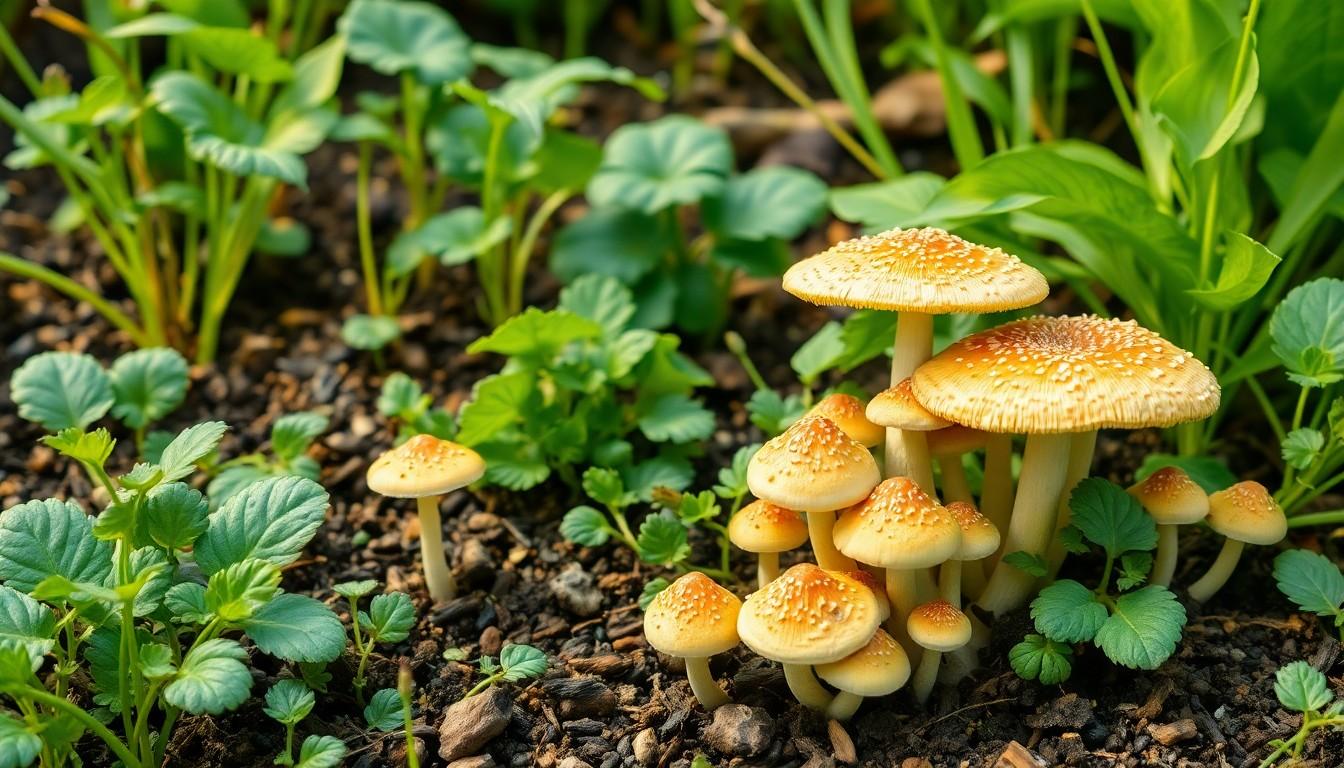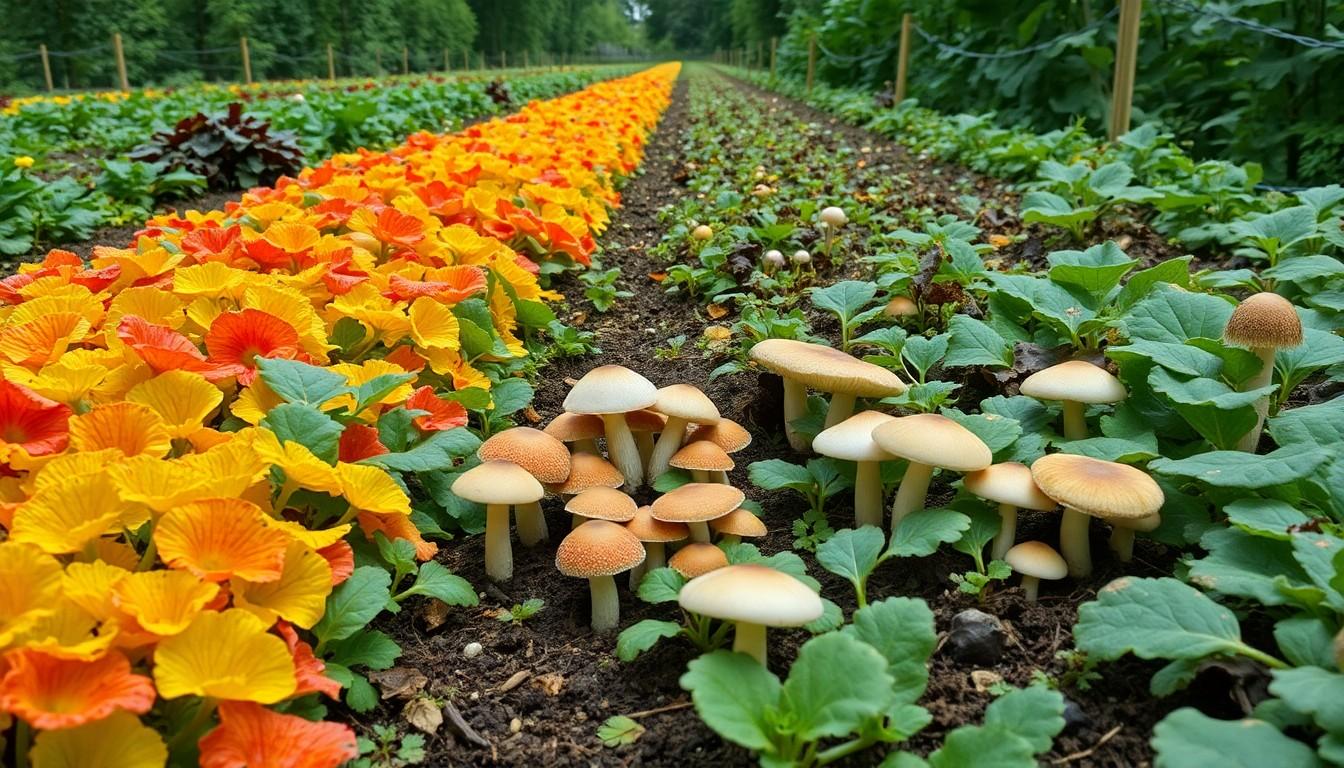Mushrooms popping up in a vegetable garden can feel like a surprise party—only instead of confetti, you get fungi. While some may panic at the sight of these mysterious caps, others see an opportunity for culinary adventure. After all, who wouldn’t want to add a dash of gourmet flair to their homegrown veggies?
Overview of Mushrooms in Vegetable Gardens
Mushrooms in vegetable gardens can indicate various conditions. Sometimes, these fungi result from organic matter decomposition. Healthy soil often supports mushroom growth due to rich microbial activity. Certain types of mushrooms thrive in damp, shaded areas, making them common in gardens with high moisture levels.
Gardeners may find several types of mushrooms, including edible varieties like shiitake and chanterelles. While some mushrooms can enhance culinary flavors, others may be toxic. Identification is crucial to ensure safe consumption; it’s important to consult reliable resources or experts before harvesting.
Environmental influences also play a significant role in mushroom emergence. Seasonal changes, especially increased humidity, often promote fungal growth. Mulching with organic materials frequently contributes to mushroom presence. Wood chips, straw, and leaves break down, creating an optimal breeding ground for spores.
Mushrooms can also help with soil health. They form symbiotic relationships with plant roots, enhancing nutrient absorption. This relationship boosts the overall vitality of the vegetable garden. On the other hand, some mushrooms may compete with plants for nutrients, impacting growth negatively.
Regular garden maintenance can manage mushroom growth effectively. Removing debris and maintaining proper drainage can reduce excess moisture. Adjusting soil pH may also deter unwanted fungi. Monitoring for mushroom presence promotes a balanced ecosystem in the garden and can enhance the gardener’s understanding of soil health.
Benefits of Mushrooms in Gardens

Mushrooms offer several advantages in vegetable gardens. Their presence can indicate a thriving ecosystem, highlighting the interconnectedness of soil health and nutrient availability.
Nutrient Enrichment
Mushrooms contribute essential nutrients to the soil. They break down organic matter, releasing nitrogen, phosphorus, and potassium. This process enriches the garden soil, enhancing plant growth. Various mushrooms support nitrogen fixation, improving overall soil fertility. In addition, mushroom mycelium increases nutrient absorption efficiency, allowing plants to take up vital elements more effectively. Many gardeners embrace this natural source of nourishment, creating a sustainable environment without the need for chemical fertilizers.
Soil Health
Healthy soil supports strong plant growth, and mushrooms play a critical role in this process. They form symbiotic relationships with plant roots, aiding in nutrient exchange. Enhanced microbial activity from mushrooms creates a more robust soil ecosystem. This dynamic improves soil structure, enhances drainage, and prevents erosion. Gardeners often notice a more balanced pH level in areas populated by mushrooms, resulting in a favorable environment for vegetable crops. Observing these fungi signals thriving soil conditions, indicating a garden’s vitality.
Common Types of Mushrooms
Mushrooms in vegetable gardens vary widely, encompassing both edible and toxic varieties. Understanding these types enhances a gardener’s knowledge and food safety.
Edible Varieties
Common edible mushrooms include shiitake, portobello, and chanterelles. Shiitake mushrooms thrive on decaying wood, offering a rich flavor to dishes. Portobello mushrooms, known for their large caps, are excellent for grilling and roasting. Chanterelles, with their distinct golden color, provide a delicate taste and pair well with various vegetables. Many gardeners successfully cultivate these varieties, adding diversity to their vegetable plots. Harvesting these mushrooms requires proper identification, ensuring safety and quality.
Toxic Varieties
Some mushrooms pose significant risks, making identification critical. Examples of toxic mushrooms include the death cap and the fly agaric. The death cap mushroom contains harmful toxins and resembles edible varieties, which can lead to serious illness or death. Fly agaric mushrooms are often brightly colored, but their psychoactive properties can cause distress. Recognizing these toxic species is essential for safe gardening. Gardeners should avoid consumption of any unknown mushrooms, often seeking guidance from local experts or reliable resources.
Factors Influencing Mushroom Growth
Mushrooms growing in a vegetable garden depend on multiple factors that create ideal conditions for their development. Understanding these factors enhances gardening practices.
Moisture Levels
Moisture levels significantly influence mushroom growth. Fungi thrive in damp environments; thus, frequent watering or heavy rainfall can create favorable conditions. Excessive moisture can lead to rapid mushroom proliferation. However, inadequate moisture could hinder their growth. Balancing irrigation practices helps in managing water levels effectively.
Soil Composition
Soil composition plays a critical role in mushroom development. Rich organic matter, including decomposing leaves or compost, provides nutrients essential for fungi. A healthy mix of sand, silt, and clay can also support diverse mushroom species. Soil pH, ideally between 6.0 and 7.0, contributes to favorable conditions for mycelium. Regular soil testing helps identify nutrient deficiencies.
Temperature Conditions
Temperature conditions impact the fruiting of mushrooms. Most fungi prefer temperatures between 60°F and 70°F for optimal growth. Cooler temperatures may delay growth, while excessive heat can inhibit it altogether. Seasonal fluctuations often affect mushroom appearance, making spring and fall prime times for growth. Maintaining suitable temperature ranges encourages a thriving mushroom population.
Managing Mushrooms in Your Garden
Mushrooms can be both beneficial and challenging in vegetable gardens. Proper management helps optimize their positive impact while minimizing potential issues.
Encouraging Healthy Growth
To encourage healthy mushroom growth, maintain adequate moisture levels in the soil. Adding organic matter like compost can create a hospitable environment for mycelium. Incorporating mulch into garden beds aids moisture retention and promotes beneficial fungi. Additionally, ensuring a balanced pH range of 6 to 7 supports diverse mushroom species. Seasonal fluctuations play a significant role, so monitor temperatures between 60°F and 70°F for ideal conditions. Regularly rotating crops also contributes to a healthier soil ecosystem, promoting nutrient availability and fostering mushroom growth.
Controlling Unwanted Fungi
Controlling unwanted fungi relies on effective garden maintenance. Regularly removing debris, such as fallen leaves and overripe vegetables, minimizes hiding places for fungi. Adequate drainage reduces excess moisture, which discourages the growth of unwanted mushrooms. Monitoring irrigation practices ensures that soil remains moist but not oversaturated. When encountering toxic varieties, avoid disturbing them while recognizing their potential harm. Seeking guidance from local experts proves essential for identifying unwanted species and determining appropriate action. Using sterilized soil or raised garden beds can help control unwanted mushroom growth while encouraging beneficial organisms.
Conclusion
Mushrooms in vegetable gardens can be both a surprise and a blessing. They indicate a thriving ecosystem and contribute to soil health while offering culinary delights. Gardeners should embrace the presence of edible mushrooms while staying vigilant about identifying toxic varieties.
By understanding the conditions that foster mushroom growth, gardeners can enhance their practices and maintain a balanced environment. Regular maintenance and proper management strategies will ensure that mushrooms remain a beneficial addition rather than a nuisance. With the right approach, mushrooms can enrich the garden experience and promote sustainable gardening practices.

